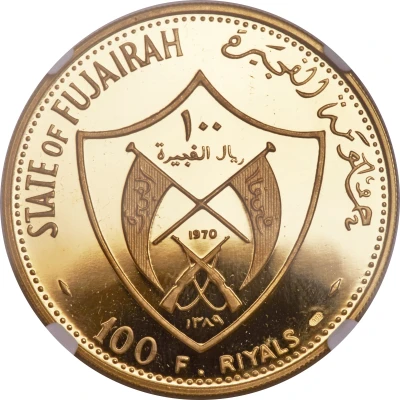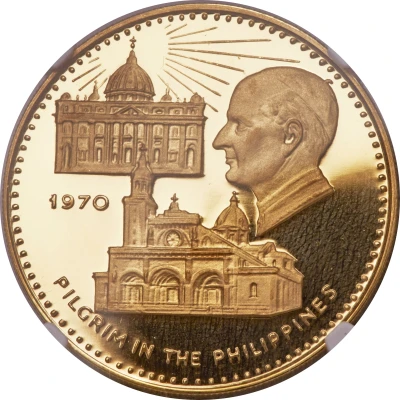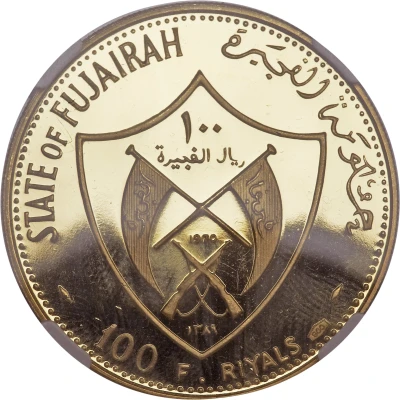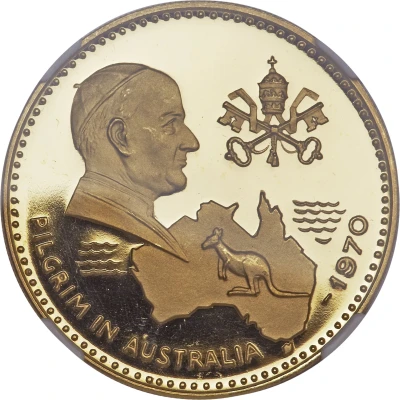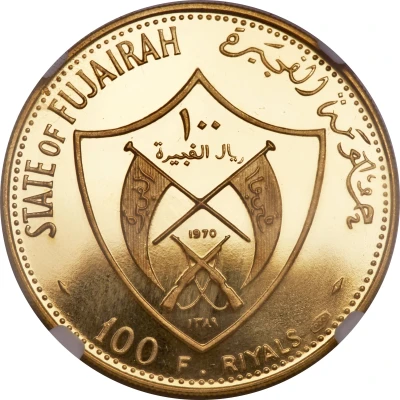
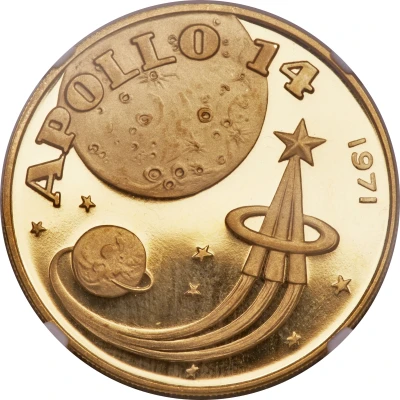

© Heritage Auctions
100 Riyals - Mohammed Apollo XIV
1389 (1970) year| Gold (.900) | 20.73 g | 35.5 mm |
| Issuer | Fujairah (United Arab Emirates) |
|---|---|
| Ruling authority | Mohammed bin Hamad Al Sharqi (1938-1974) |
| Type | Non-circulating coin |
| Year | 1389 (1970) |
| Calendar | Islamic (Hijri) |
| Value | 100 Riyals |
| Currency | Riyal (1966-1973) |
| Composition | Gold (.900) |
| Weight | 20.73 g |
| Diameter | 35.5 mm |
| Shape | Round |
| Technique | Milled |
| Orientation | Coin alignment ↑↓ |
| Demonetized | 1973 |
| Updated | 2024-10-08 |
| Numista | N#95798 |
|---|---|
| Rarity index | 94% |
Reverse
Moon on top and shooting star within ring below coming out of a planet at left
Script: Latin
Lettering:
APOLLO 14
1971
Edge
Reeded
Comment
Official Proof Set (unlisted in Krause) containing all 9 silver and 9 gold coins of Fujairah:© Image courtesy of UAE Coin Collectors Club
Apollo 14 was the eighth manned mission in the United States Apollo program, and the third to land on the Moon. It was the last of the "H missions," targeted landings with two-day stays on the Moon with two lunar EVAs, or moonwalks.
Commander Alan Shepard, Command Module Pilot Stuart Roosa, and Lunar Module Pilot Edgar Mitchell launched on their nine-day mission on January 31, 1971 at 4:04:02 p.m. local time after a 40-minute, 2 second delay due to launch site weather restrictions, the first such delay in the Apollo program. Shepard and Mitchell made their lunar landing on February 5 in the Fra Mauro formation - originally the target of the aborted Apollo 13 mission. During the two lunar EVAs, 42.80 kilograms (94.35 lb) of Moon rocks were collected, and several scientific experiments were performed. Shepard hit two golf balls on the lunar surface with a makeshift club he had brought from Earth. Shepard and Mitchell spent 33½ hours on the Moon, with almost 9½ hours of EVA.
In the aftermath of Apollo 13, several modifications were made to the Service Module electrical power system to prevent a repeat of that accident, including redesign of the oxygen tanks and addition of a third tank.
While Shepard and Mitchell were on the surface, Roosa remained in lunar orbit aboard the Command/Service Module Kitty Hawk, performing scientific experiments and photographing the Moon, including the landing site of the future Apollo 16 mission. He took several hundred seeds on the mission, many of which were germinated on return, resulting in the so-called Moon trees. Shepard, Roosa, and Mitchell landed in the Pacific Ocean on February 9.
Interesting fact
The 100 Riyals - Mohammed (Apollo XIV) 1389 (1970) coin from Fujairah (United Arab Emirates) is an interesting piece of numismatic history. One fascinating fact about this coin is that it was minted to commemorate the Apollo 14 mission, which was the third manned mission to land on the moon. The coin features an image of the moon landing on one side and the portrait of Mohammed, the Prophet of Islam, on the other. This unique combination of space exploration and religious symbolism makes this coin stand out among other numismatic items.
Price
| Date | Mintage | VG | F | VF | XF | AU | UNC |
|---|---|---|---|---|---|---|---|
| 1389 (1970) | 550 | - | - | - | - | - | - |
Values in the table are based on evaluations by sales realized on Internet platforms. They serve as an indication only for 100 Riyals - Mohammed (Apollo XIV) 1389 (1970) coin.
